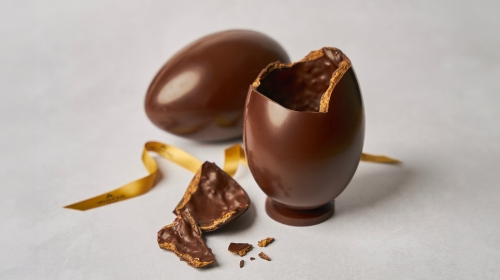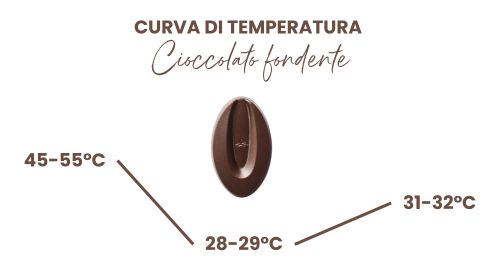Make your own homemade chocolate egg this Easter
This year, you've decided to take the plunge: You’re going to make your own chocolate Easter egg! Are you beginning to get the hang of basic pastry techniques and recipes? Then now’s the time to try your hand at the art of chocolate molding and make your own Easter eggs. To help you with your latest project, Valrhona is sharing some tips courtesy of French chef Philippe Tayac. Follow his step-by-step recipe and tips in this article.
Before making your chocolate Easter egg
Choose professional-quality ingredients for your recipe
Chefs’ recipes call for professional-quality ingredients! You will need:
- Valrhona pastry-making chocolate (also known as couverture chocolate). Couverture chocolate contains a slightly higher proportion of cocoa butter. This makes it easier and more fluid to work with and means you will be able to temper it. In his recipe, the chef uses Oriado 60%, an organic dark chocolate, and Jivara 40%, a milk chocolate.
- Valrhona almond and hazelnut praliné
- Gianduja (chocolate hazelnut paste) or, if you prefer, Azélia 35% milk chocolate with its delicious hazelnut notes.
Order your Valrhona chocolate and other professional-quality ingredients from Valrhona Collection, our online store for people who love pastry-making.
Making a homemade chocolate egg with a mold
You'll need an egg mold to make this recipe. We recommend the 17cm egg mold. It has two indents, so it works for both sides. It's also available in a smaller size (13cm), but you'll need to adapt the recipe’s quantities. You can also opt for the bell mold if you’re going for a more original look.
Homemade Easter eggs: choosing the right equipment
You will need these utensils to get the best results:
- A cooking thermometer or probe thermometer: This is vital for tempering chocolate.
- An angled spatula: This is handy for spreading the filling.
- A spatula: This will help you mix your chocolate thoroughly without incorporating any air bubbles.
- A rack so you can place your half-eggs upside down and remove any excess chocolate from the mold.
How to make a chocolate Easter egg
The Indulgence egg: Follow the step-by-step instructions for this fillable homemade egg

Chocolate tempering: the all-important first step
As you might already know, tempering involves changing chocolate into a series of different states: It melts, then it resets, before it is finally reheated. This technique makes the chocolate solid and shiny, and prevents it from developing bloom. Luckily, you can find a comprehensive article on tempering chocolate here. You can temper chocolate in a bain-marie or even in the microwave, so long as you keep a close eye on it. Here's the tempering chart for dark chocolate, which you will need to follow for this recipe.

Don’t forget that the chart isn’t the same if you’re working with milk, white, or Inspiration chocolate.
Tips from chef Philippe Tayac
Philippe Tayac's tips for the Indulgence egg.
How to make chocolate shells with a mold
- Before pouring the tempered dark chocolate into the mold, the latter must be clean and dry. If this isn’t the case, your molded chocolate will have blemishes.
- When pouring the chocolate into the mold, make sure you spread it evenly over the entire surface.
- Turn your molds out onto a wire rack and wait for any excess to drip away.
- Leave the chocolate to set for 20 minutes in the refrigerator.
- Trim the shells using a knife (scrape off any excess chocolate that has set around the edges of the mold).
- If you turn the mold over in your hands, the chocolate shell should slip out easily.
How to fill the egg
Once you have reached this step, it’s important you leave the chocolate shells in their molds while you fill them. This will allow you to avoid leaving any fingerprints, melting the chocolate - and, most importantly, breaking it!
The Indulgence egg recipe can be varied in a few ways:
- Add a second layer of Oriado 60% on top of the crisp once it has set.
- Skip the filling if all you want is a chocolate egg.
- Fill the egg with smaller praliné eggs.
- Replace the crêpe dentelle wafer with chopped nuts (such ashazelnuts or pistachios , for example).
How to stick the two sides of the chocolate egg together
Chef Philippe uses a hot plate heated to 136/140°F (58/60°C) to stick the two shells together. If you don't have a hot plate, we recommend using the bottom of a saucepan.
How to make an Easter egg base
Here’s a real chef’s tip! The lid of your Valrhona praliné jar will help you make a base for your egg. Pour out and mold some chocolate onto the lid, leave it to set, then separate the lid from the chocolate. Run the back of a spoon under hot water, then rub it against the chocolate to make a slight hollow for the Easter egg.
How to store chocolate eggs
If you have successfully tempered the chocolate, your molded egg can be stored at room temperature. Bear in mind, however, that the ideal storage temperature for chocolate is 57/64°F (14/18°C). So don't leave yours in an overly heated room!
Now you're ready to make your own Indulgence egg. We hope your friends and family will be impressed by your chocolate-making skills!
Check out other delicious Easter recipes in the Recipes section, or other technical articles about pastry-making on our blog.
 Microsoft Edge
Microsoft Edge
 Google Chrome
Google Chrome
 Mozilla Firefox
Mozilla Firefox
 Opéra
Opéra


